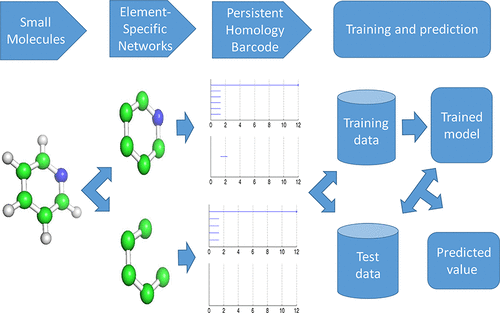当前位置:
X-MOL 学术
›
J. Chem. Inf. Model.
›
论文详情
Our official English website, www.x-mol.net, welcomes your feedback! (Note: you will need to create a separate account there.)
Quantitative Toxicity Prediction Using Topology Based Multitask Deep Neural Networks
Journal of Chemical Information and Modeling ( IF 5.6 ) Pub Date : 2018-01-31 00:00:00 , DOI: 10.1021/acs.jcim.7b00558 Kedi Wu 1 , Guo-Wei Wei 1
Journal of Chemical Information and Modeling ( IF 5.6 ) Pub Date : 2018-01-31 00:00:00 , DOI: 10.1021/acs.jcim.7b00558 Kedi Wu 1 , Guo-Wei Wei 1
Affiliation

|
The understanding of toxicity is of paramount importance to human health and environmental protection. Quantitative toxicity analysis has become a new standard in the field. This work introduces element specific persistent homology (ESPH), an algebraic topology approach, for quantitative toxicity prediction. ESPH retains crucial chemical information during the topological abstraction of geometric complexity and provides a representation of small molecules that cannot be obtained by any other method. To investigate the representability and predictive power of ESPH for small molecules, ancillary descriptors have also been developed based on physical models. Topological and physical descriptors are paired with advanced machine learning algorithms, such as the deep neural network (DNN), random forest (RF), and gradient boosting decision tree (GBDT), to facilitate their applications to quantitative toxicity predictions. A topology based multitask strategy is proposed to take the advantage of the availability of large data sets while dealing with small data sets. Four benchmark toxicity data sets that involve quantitative measurements are used to validate the proposed approaches. Extensive numerical studies indicate that the proposed topological learning methods are able to outperform the state-of-the-art methods in the literature for quantitative toxicity analysis. Our online server for computing element-specific topological descriptors (ESTDs) is available at http://weilab.math.msu.edu/TopTox/.
中文翻译:

基于拓扑的多任务深度神经网络的定量毒性预测
对毒性的理解对于人类健康和环境保护至关重要。定量毒性分析已成为该领域的新标准。这项工作介绍了元素特定的持久同源性(ESPH),一种用于定量毒性预测的代数拓扑方法。ESPH在几何复杂性的拓扑抽象过程中保留了重要的化学信息,并提供了其他任何方法都无法获得的小分子的表示。为了研究ESPH对于小分子的可表示性和预测能力,还基于物理模型开发了辅助描述符。拓扑和物理描述符与先进的机器学习算法配对,例如深度神经网络(DNN),随机森林(RF)和梯度提升决策树(GBDT),促进其在定量毒性预测中的应用。提出了一种基于拓扑的多任务策略,以利用大数据集的可用性同时处理小数据集的优势。使用涉及定量测量的四个基准毒性数据集来验证所提出的方法。大量的数值研究表明,提出的拓扑学习方法能够胜过文献中用于定量毒性分析的最新方法。我们的用于计算特定于元素的拓扑描述符(ESTD)的在线服务器可从http://weilab.math.msu.edu/TopTox/获得。提出了一种基于拓扑的多任务策略,以利用大数据集的可用性同时处理小数据集的优势。使用涉及定量测量的四个基准毒性数据集来验证所提出的方法。大量的数值研究表明,提出的拓扑学习方法能够胜过文献中用于定量毒性分析的最新方法。我们的用于计算特定于元素的拓扑描述符(ESTD)的在线服务器可从http://weilab.math.msu.edu/TopTox/获得。提出了一种基于拓扑的多任务策略,以利用大数据集的可用性同时处理小数据集的优势。使用涉及定量测量的四个基准毒性数据集来验证所提出的方法。大量的数值研究表明,提出的拓扑学习方法能够胜过文献中用于定量毒性分析的最新方法。我们的用于计算特定于元素的拓扑描述符(ESTD)的在线服务器可从http://weilab.math.msu.edu/TopTox/获得。大量的数值研究表明,提出的拓扑学习方法能够胜过文献中用于定量毒性分析的最新方法。我们的用于计算特定于元素的拓扑描述符(ESTD)的在线服务器可从http://weilab.math.msu.edu/TopTox/获得。大量的数值研究表明,提出的拓扑学习方法能够胜过文献中用于定量毒性分析的最新方法。我们的用于计算特定于元素的拓扑描述符(ESTD)的在线服务器可从http://weilab.math.msu.edu/TopTox/获得。
更新日期:2018-01-31
中文翻译:

基于拓扑的多任务深度神经网络的定量毒性预测
对毒性的理解对于人类健康和环境保护至关重要。定量毒性分析已成为该领域的新标准。这项工作介绍了元素特定的持久同源性(ESPH),一种用于定量毒性预测的代数拓扑方法。ESPH在几何复杂性的拓扑抽象过程中保留了重要的化学信息,并提供了其他任何方法都无法获得的小分子的表示。为了研究ESPH对于小分子的可表示性和预测能力,还基于物理模型开发了辅助描述符。拓扑和物理描述符与先进的机器学习算法配对,例如深度神经网络(DNN),随机森林(RF)和梯度提升决策树(GBDT),促进其在定量毒性预测中的应用。提出了一种基于拓扑的多任务策略,以利用大数据集的可用性同时处理小数据集的优势。使用涉及定量测量的四个基准毒性数据集来验证所提出的方法。大量的数值研究表明,提出的拓扑学习方法能够胜过文献中用于定量毒性分析的最新方法。我们的用于计算特定于元素的拓扑描述符(ESTD)的在线服务器可从http://weilab.math.msu.edu/TopTox/获得。提出了一种基于拓扑的多任务策略,以利用大数据集的可用性同时处理小数据集的优势。使用涉及定量测量的四个基准毒性数据集来验证所提出的方法。大量的数值研究表明,提出的拓扑学习方法能够胜过文献中用于定量毒性分析的最新方法。我们的用于计算特定于元素的拓扑描述符(ESTD)的在线服务器可从http://weilab.math.msu.edu/TopTox/获得。提出了一种基于拓扑的多任务策略,以利用大数据集的可用性同时处理小数据集的优势。使用涉及定量测量的四个基准毒性数据集来验证所提出的方法。大量的数值研究表明,提出的拓扑学习方法能够胜过文献中用于定量毒性分析的最新方法。我们的用于计算特定于元素的拓扑描述符(ESTD)的在线服务器可从http://weilab.math.msu.edu/TopTox/获得。大量的数值研究表明,提出的拓扑学习方法能够胜过文献中用于定量毒性分析的最新方法。我们的用于计算特定于元素的拓扑描述符(ESTD)的在线服务器可从http://weilab.math.msu.edu/TopTox/获得。大量的数值研究表明,提出的拓扑学习方法能够胜过文献中用于定量毒性分析的最新方法。我们的用于计算特定于元素的拓扑描述符(ESTD)的在线服务器可从http://weilab.math.msu.edu/TopTox/获得。


























 京公网安备 11010802027423号
京公网安备 11010802027423号